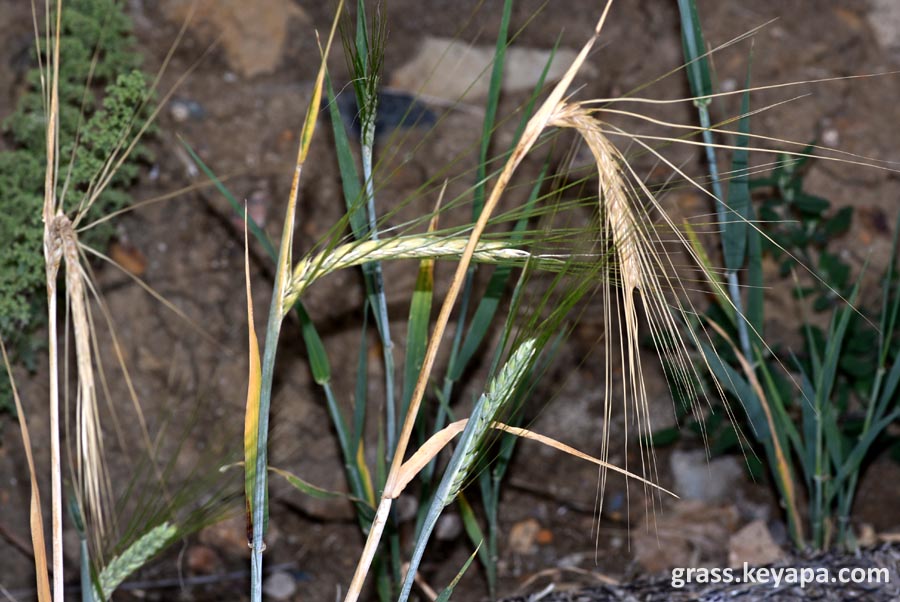
Note: Thank you to a reader for pointing out that skin pigmentation may also have been changed dramatically by the onset of agriculture.
Did you know that many of the attributes of people today are a direct result of a few grasses?
The domestication of grasses for agriculture started several thousand years ago, and occurred independently in different areas in the world. Wheat (Triticum spp) domestication began at around 12,000 years ago (12 ka – “kilo annum”) in the Fertile Crescent (modern-day Iraq, Iran, Israel, Jordan, Lebanon, Palestine, Syria, and Turkey), while rice (Oryza sativa) was first domesticated in East Asia around 9 ka to 8 ka (Katamadze et al 2023; Callaway 2014).

On the other side of the world, and at around the same time, maize/corn (Zea mays) was domesticated from wild grass in the Balsas region of southwest Mexico (Stitzer and Ross-Ibarra, 2018). A fourth cereal barley (Hordeum vulgare) also was domesticated in the Fertile Crescent (Guo, 2025). Finally, Sorghum (Sorghum bicolor) was domesticated in central eastern Sudan approximately 6 ka to 4 ka (Ge et al, 2022).

Changes to the phenotypic and genetic attributes of domesticated grains were dramatic, and were a clear example of rapid evolution via selection. Most of the changes to the grains were adaptive towards their new role as major providers of food for the growing multitudes of people.
These changes can be grouped into traits that were associated with harvesting requirements, seedling competition, and seed production/use. For example, the wild progenitors of domesticated grasses usually have shattering seeds, which means that ripe seeds are released from the mother plant. But this would prevent harvesting of the grains, and so over the course of generations the trait was bred out of domesticated grains and they now have non-shattering seeds which remain attached even when ripe. There was also a general increase in seed size and in the content of carbohydrates compared to proteins in these grasses, due mainly to larger seed endosperms, which contains more carbohydrates than proteins (Glémin, S. and Bataillon, 2009).

But these adaptations and changes in domesticated grasses were not by any means a one way street. The long partnership between the cereals and humanity also shaped human evolution in extremely significant ways.
The change from a hunter-gatherer lifestyle to a more sedentary and perhaps less physically demanding agricultural one caused major changes in the human form. Grains by themselves do not provide all the nutrients that a diverse diet does, and there was a decrease in human stature and musculature due to this nutritional deficiency and less need for physically demanding activities (Latham, 2013).

The advent of agriculture also resulted in major changes in the structure of the human skull. The underlying shape of our faces is tied to our food intake, and the spread of softer grain-derived food caused people to have smaller faces with smaller jaws and teeth. The decrease in tooth size in turn caused crowding of the teeth, and the tight spaces between teeth promoted bacterial growth and thus increases of periodontal diseases (Latham, 2013; Katz et al, 2017). But other major changes to humanity due to the rise of domesticated grasses involved less obvious attributes.

The enzyme amylase is used to digest starch into sugars, and primates such as bonobos, chimpanzees, and Homo neanderthalensis all have only a single copy of the salivary amylase gene, as well one copy each of the two genes for pancreatic amylase. However, humans today have multiple copies of these genes!
In our case, we have up to 11 copies of the gene for salivary amylase, and up to 3 or 4 copies of the genes for the two pancreatic amylases. This significant change in amylase gene copies are likely because a diet based on grains is very high in starch, and having more copies of the genes (and thus more resulting enzymes to digest the starch into sugars) has been very advantageous to our ancestors (Bolognini et al, 2024).
Finally, a new paper (pre-print and thus not yet fully peer reviewed) seems to indicate that the evolution of pale skin may have occurred fairly recently and was an indirect result of the relationship of people with domesticated grasses. The researchers found that even 5 ka to 3 ka only half the people in Europe had light skin, and that it was only after 3 ka that pale skin became the predominant skin color. They hypothesized that the change in diet due to agriculture created a situation where people were not getting enough vitamin D from their diets, and thus some people evolved light skin in order to synthesize it directly from UV rays from the sun (Perretti et al, 2025).
In the end, the domestication of select grasses, and the advent of agriculture due to this partnership, was not only a major turning point in human evolution, but it also resulted in the rise of civilization and all the benefits that accrued from that event. But that’s a story for another time.
Literature Cited
Bolognini, D., Halgren, A., Lou, R.N. et al. (2024) Recurrent evolution and selection shape structural diversity at the amylase locus. Nature 634, 617–625 (2024). https://doi.org/10.1038/s41586-024-07911-1
Callaway, E. Domestication: The birth of rice. Nature 514, S58–S59 (2014). https://doi.org/10.1038/514S58a
Ge F, Xie P, Wu Y, Xie Q. (2022) Genetic architecture and molecular regulation of sorghum domestication. aBIOTECH. 2022 Dec 19;4(1):57-71. doi: 10.1007/s42994-022-00089-y. PMID: 37220542; PMCID: PMC10199992.
Glémin, S. and Bataillon, T. (2009), A comparative view of the evolution of grasses under domestication. New Phytologist, 183: 273-290. https://doi.org/10.1111/j.1469-8137.2009.02884.x
Guo, Y., Jayakodi, M., Himmelbach, A. et al. (2025) A haplotype-based evolutionary history of barley domestication. Nature https://doi.org/10.1038/s41586-025-09533-7
Katamadze Artūrs , Omar Vergara-Díaz, Estefanía Uberegui, Ander Yoldi-Achalandabaso, José Luis Araus, Rubén Vicente (2023).
Evolution of wheat architecture, physiology, and metabolism during domestication and further cultivation: Lessons for crop improvement,
The Crop Journal, Volume 11, Issue 4, Pages 1080-1096
Katz DC, Grote MN, Weaver TD (2017). Changes in human skull morphology across the agricultural transition are consistent with softer diets in preindustrial farming groups. Proc Natl Acad Sci U S A. 2017 Aug 22;114(34):9050-9055. doi: 10.1073/pnas.1702586114. Epub 2017 Jul 24. PMID: 28739900; PMCID: PMC5576786.
Latham, Katherine. (2013). Human Health and the Neolithic Revolution: an Overview of Impacts of the Agricultural Transition on Oral Health, Epidemiology, and the Human Body.
Perretti, S., Vizzari, M. T., Santos, P., Tassani, E., Benazzo, A., Ghirotto, S., & Barbujani, G. (2025). Inference of human pigmentation from ancient DNA by genotype likelihood. doi:10.1101/2025.01.29.635495
Stitzer, M.C. and Ross-Ibarra, J. (2018), Maize domestication and gene interaction. New Phytol, 220: 395-408. https://doi.org/10.1111/nph.15350

Leave a Reply to admin Cancel reply